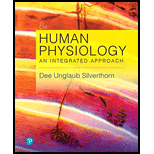
EBK HUMAN PHYSIOLOGY
8th Edition
ISBN: 9780134704227
Author: Silverthorn
Publisher: YUZU
expand_more
expand_more
format_list_bulleted
Question
Chapter 23, Problem 18RQ
a.
Summary Introduction
To determine: The amount of Ca2+ a person filters in a day.
Introduction: GFR (glomerular filtration rate) describes the amount of fluid that filters into Bowman’s capsule per unit time.
b.
Summary Introduction
To determine: The amount of Ca2+ a person must excrete to balance the Ca2+ level in the body.
Introduction: The total body Ca2+ is all the calcium in the body, which is distributed among three compartments: extracellular fluid, intracellular Ca2+, and extracellular matrix (bone).
c.
Summary Introduction
To determine: The percentage of filtered Ca2+ to be reabsorbed by the renal tubule.
Introduction: The Ca2+ loss from the body occurs primarily through the kidneys, with a small amount excreted in feces.
Expert Solution & Answer
Want to see the full answer?
Check out a sample textbook solution
Students have asked these similar questions
State the five functions of Globular Proteins, and give an example of a protein for each function.
Diagram of check cell under low power and high power
a couple in which the father has the a blood type and the mother has the o blood type produce an offspring with the o blood type, how does this happen? how could two functionally O parents produce an offspring that has the a blood type?
Chapter 23 Solutions
EBK HUMAN PHYSIOLOGY
Ch. 23.2 - Prob. 1CCCh. 23.2 - Prob. 2CCCh. 23.2 - What do the abbreviations HPA and CBG stand for?...Ch. 23.2 - Prob. 4CCCh. 23.2 - Prob. 5CCCh. 23.2 - Prob. 6CCCh. 23.2 - Would someone with Addisons disease have normal,...Ch. 23.2 - Prob. 8CCCh. 23.3 - A woman who had her thyroid gland removed because...Ch. 23.3 - Prob. 10CC
Ch. 23.4 - Prob. 11CCCh. 23.5 - Prob. 12CCCh. 23.5 - Prob. 13CCCh. 23.6 - Prob. 14CCCh. 23.6 - Prob. 15CCCh. 23.6 - Prob. 16CCCh. 23.6 - Prob. 17CCCh. 23 - Name the zones of the adrenal cortex and the...Ch. 23 - For (a) cortisol, (b) growth hormone, (c)...Ch. 23 - Prob. 3RQCh. 23 - Prob. 4RQCh. 23 - Define each of the following terms and explain its...Ch. 23 - Prob. 6RQCh. 23 - Prob. 7RQCh. 23 - Prob. 8RQCh. 23 - Define, compare, and contrast or relate the terms...Ch. 23 - Prob. 10RQCh. 23 - Prob. 11RQCh. 23 - Osteoclasts make acid (H+) from CO2 and H2O. They...Ch. 23 - Prob. 13RQCh. 23 - One diagnostic test to determine the cause of...Ch. 23 - Prob. 15RQCh. 23 - Prob. 16RQCh. 23 - Prob. 17RQCh. 23 - Prob. 18RQCh. 23 - Prob. 19RQ
Knowledge Booster
Learn more about
Need a deep-dive on the concept behind this application? Look no further. Learn more about this topic, biology and related others by exploring similar questions and additional content below.Similar questions
- What is the opening indicated by the pointer? (leaf x.s.) stomate guard cell lenticel intercellular space none of thesearrow_forwardIdentify the indicated tissue? (stem x.s.) parenchyma collenchyma sclerenchyma ○ xylem ○ phloem none of thesearrow_forwardWhere did this structure originate from? (Salix branch root) epidermis cortex endodermis pericycle vascular cylinderarrow_forward
- Identify the indicated tissue. (Tilia stem x.s.) parenchyma collenchyma sclerenchyma xylem phloem none of thesearrow_forwardIdentify the indicated structure. (Cucurbita stem l.s.) pit lenticel stomate tendril none of thesearrow_forwardIdentify the specific cell? (Zebrina leaf peel) vessel element sieve element companion cell tracheid guard cell subsidiary cell none of thesearrow_forward
- What type of cells flank the opening on either side? (leaf x.s.) vessel elements sieve elements companion cells tracheids guard cells none of thesearrow_forwardWhat specific cell is indicated. (Cucurbita stem I.s.) vessel element sieve element O companion cell tracheid guard cell none of thesearrow_forwardWhat specific cell is indicated? (Aristolochia stem x.s.) vessel element sieve element ○ companion cell O O O O O tracheid O guard cell none of thesearrow_forward
- Identify the tissue. parenchyma collenchyma sclerenchyma ○ xylem O phloem O none of thesearrow_forwardPlease answer q3arrow_forwardRespond to the following in a minimum of 175 words: How might CRISPR-Cas 9 be used in research or, eventually, therapeutically in patients? What are some potential ethical issues associated with using this technology? Do the advantages of using this technology outweigh the disadvantages (or vice versa)? Explain your position.arrow_forward
arrow_back_ios
SEE MORE QUESTIONS
arrow_forward_ios
Recommended textbooks for you
 Human Physiology: From Cells to Systems (MindTap ...BiologyISBN:9781285866932Author:Lauralee SherwoodPublisher:Cengage Learning
Human Physiology: From Cells to Systems (MindTap ...BiologyISBN:9781285866932Author:Lauralee SherwoodPublisher:Cengage Learning Biology (MindTap Course List)BiologyISBN:9781337392938Author:Eldra Solomon, Charles Martin, Diana W. Martin, Linda R. BergPublisher:Cengage Learning
Biology (MindTap Course List)BiologyISBN:9781337392938Author:Eldra Solomon, Charles Martin, Diana W. Martin, Linda R. BergPublisher:Cengage Learning Human Biology (MindTap Course List)BiologyISBN:9781305112100Author:Cecie Starr, Beverly McMillanPublisher:Cengage Learning
Human Biology (MindTap Course List)BiologyISBN:9781305112100Author:Cecie Starr, Beverly McMillanPublisher:Cengage Learning

Human Physiology: From Cells to Systems (MindTap ...
Biology
ISBN:9781285866932
Author:Lauralee Sherwood
Publisher:Cengage Learning


Biology (MindTap Course List)
Biology
ISBN:9781337392938
Author:Eldra Solomon, Charles Martin, Diana W. Martin, Linda R. Berg
Publisher:Cengage Learning



Human Biology (MindTap Course List)
Biology
ISBN:9781305112100
Author:Cecie Starr, Beverly McMillan
Publisher:Cengage Learning
Excretory System; Author: Amoeba Sisters;https://www.youtube.com/watch?v=q5qaGHfdmYM;License: Standard youtube license